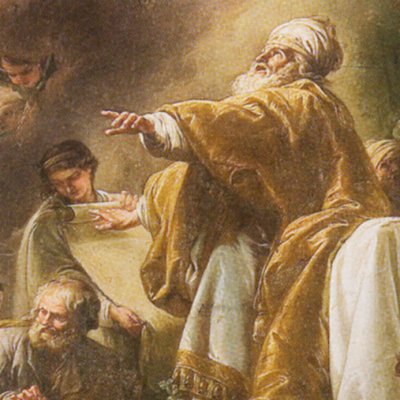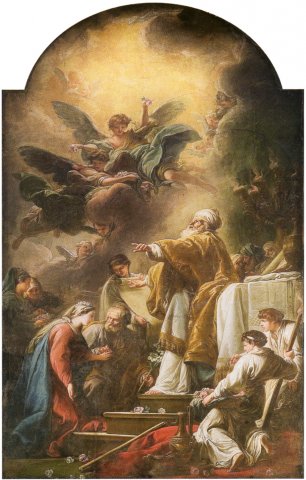The Marriage of the Blessed Virgin - Deshays
Notice précédente Notice n°26 sur 77 Notice suivante
Description
Booklet from the 1763 Salon:
By Mr. Deshays, Assistant to Professor,
42. The Marriage of the Blessed Virgin.
Painting 19 feet high, 11 feet wide."
Extraordinary from the Mercure de France, Sept. 63, p. 25:
"The first of M. Deshays's paintings [26] not only by the grandeur of its form, but by that of composition & effect, offers the august & mysterious spectacle of the chaste marriage of the Blessed Virgin with Saint Joseph. It is more than a poet, it is an inspired prophet that the painter has treated this subject, so simple in appearance, & made so noble by the elevation of his genius. A High Priest of the Law of Moyse stands facing the Holy Spouses, on a platform in front of an Altar or Table, covered with linen napes. His arms are outstretched, and his gaze directed towards an illuminating Glory. Nothing is more expressive & divine than the character of this Head, where without effort of imagination, one reads the great Mysteries that God is revealing at this moment to His Pontiff. It seems to see & follow in Heaven the order of wonders that eternal Providence must work in the young bride we are blessing. The painter has not given this sublime character to the High Priest's head through a forced exaggeration of his features. He has, so to speak, imprinted, with the greatest warmth, in this divine enthusiasm, & the Majesty of the God who inspires, [27] & the dignity of the sacred Ministry performed by the Pontiff. Just as much intelligence characterizes the figure of the Blessed Virgin who receives at the feet of this High Priest the Conjugal Ring from the hands of Saint Joseph. It's a completely different kind of character, but it's the same accuracy and sublimity. A celestial candor illuminates, embellishes & renders even more touching the simple & at the same time very noble beauty that the Painter has given to the Virgin's head. This great & majestic simplicity is pronounced in a sensitive manner, not only on the head, but on all the parts of this beautiful Figure.
The Saint Joseph has the right expression that suits him, & in a genre analogous to the great idea that the Painter has conceived & very well rendered of this holy Hymenaeus. Two young Levites perform their duties at the feet of the Altar, in one of the lower corners of the Painting.
If the Painter has excelled in invention & in what we shall call the poetic composition of his Subject, he deserves no less admiration in picturesque execution. We must forgive him for allowing himself a little license [28] against the austere truth of Costume with regard to the High Priest's vestments, in favor of the great & magnificent effect which results. Nothing could be better understood than the draperies of this Priest's overgarment. Enthusiasm seems to reign there, as much as in the character of the head; but always with a wisdom & correctness of taste that we cannot praise too highly. The mellowness & strength that eminently characterize the Author's brushwork are especially noticeable in this painting, and the choice & effect of the fabrics are equally admirable. The wise ensemble in which the Painter has, as we said above, designated the divine vocation of the Virgin, is further complemented, so to speak, by the style & execution of the beautiful draperies of this Figure. Their noble simplicity, the understanding & sobriety of the folds are perfectly analogous to it, & are so without coldness, without dryness, & above all without that stiffness so difficult to avoid, when one practices this kind of manner of drapery. the magic of chiaroscuro & the effect of coloring, has been practiced, it seems to us, with [29] astonishing success throughout this Tableau; we have noticed it particularly in the two young Levites, both dressed in linen, standing very close to each other, & joining the cloths covering the Altar. The art of the effects, in all these same whites, is so happily employed, that the objects & each part of the objects, are of a sensible distinction, at the same time of the greatest truth, & of a great perfection of agreement with the other objects, in the whole of the Painting, of which one of the great merits is the beauty of the general harmony. This mass formed by the young Levites also produces, in relation to other effects, an advantage that has not escaped us. As it is placed in the lower corner of the Tableau, which corresponds to the upper corner where the Glory is, it contributes admirably to extending & enlarging the great effect of light which strikes on the dominant part of all this great & rich composition.
We would have to point out the brilliance of this Glory, the ingenious & pleasing relationships of effect of the accessories with the principal parts, right down to the flowers with which the tiers [30] of the Altar & the pavement of the Temple are strewn: but we would perhaps be prolix, without being sufficiently exact for that. There are objects for which any description is insufficient: this beautiful painting is one of them. Before concluding, let us address a well-founded reproach to our capital, on the fact that it abandons, as it were, to the temples of the Provinces, pieces of distinction, such as this & others that could be cited, which should remain in its bosom to serve as monumens to its splendor & to the glory of our Arts. It is more than singular that those to whom is entrusted the maintenance of the Temples, make in Province more efforts of expenses to remove from the Capital productions of price, than one does not deign to make some to preserve them there."
Mathon de La Cour, Letter II:
"We were at the Tableaux de M. Deshays. The first represents the marriage of the Blessed Virgin:[27] Mary & Joseph are kneeling on the steps of an Altar, at the feet of the Pontiff who unites them; two Acolytes, some spectators & Angels borne on clouds, fill the rest of the Tableau. There is fire & harmony in this composition; it is very effective; there is a beautiful tone of color: the Pontiff is seized with an enthusiasm that is communicated to the spectators; but balance is not sufficiently observed in the figure of one of the Acolytes. S. Joseph is fine; the Blessed Virgin could be better: the Angels would have done well not to appear at all. I don't know why M. Deshays invited them to this wedding. It is one of the least important events in the life of the Blessed Virgin, and it seems to me that it is the one that should be of least interest to the Heavenly Court. The decorations of the Temple could make such a pleasing object; the Tableau would have had more depth, [28] & the principal figures would have emerged in a happier manner.
The Jews did not marry in the Temple: for them, marriage was a civil contract, which was not clothed in any religious ceremony: it took place inside the home, in the presence of relatives; the priests did not interfere. Moreover, the use of wax torches was unknown at the time, and only lamps were used. It is unfortunate that all these parts of the costume have been forgotten in the painting we are talking about. I feel that the example of other painters will be set against me; but abuses do not become rules; customs cannot serve as an excuse for men of genius. Several errors of this kind escaped the greatest Masters in times of ignorance: they are unforgivable in a more [29] enlightened age. Le Brun and Le Sueur would certainly not have allowed themselves. Art gains nothing from these kinds of licentiousness; on the contrary, a foreign ceremony is more picturesque: it interests more, & it lends much more to the Painter's art."
2. The collegiate church of Saint-Pierre de Douai was entirely rebuilt between 1735 and 1750.
Technical Data
Notice #000748


